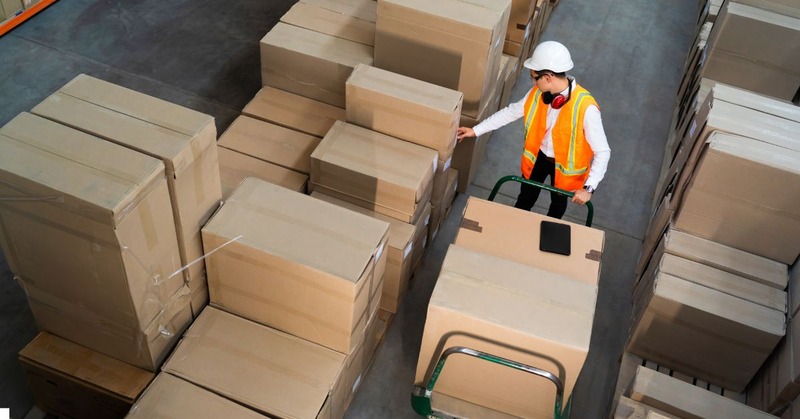Are you dealing with slow order processing, errors in shipments, or struggling to keep up with the growing demands of your customers?
Well, you're definitely not the only one.
Many businesses, just like yours, are constantly looking for solutions that can overcome these types of fulfillment challenges.
This guide to knowing what pick and pack is will make sure that you can address these pain points.
Not only that, but we'll also offer insights and solutions that can streamline your operations in a way that will enhance your customer's satisfaction, and ultimately, boost your bottom line.
Table of Contents
- What is Pick and Pack?
- Why Is It Important to Adopt a Pick and Pack Fulfillment Process?
- How Does a Pick and Pack Fulfillment Process Work?
- What are the Different Warehouse Picking and Packing Methods?
- FAQs
- Conclusion
What is Pick and Pack?

Pick and pack is an essential order fulfillment strategy commonly used in eCommerce and retail operations, where individual items are selected (picked) from bulk storage and packaged (packed) according to specific customer orders.
This process is optimized for handling small orders that are shipped globally, contrasting with shipping entire cases or pallets.
It involves strategic organization of warehouse operations to ensure efficient handling and minimal freight charges, often utilizing warehouse workers who retrieve items from storage and prepare them for shipment directly to customers.
Why Is It Important to Adopt a Pick and Pack Fulfillment Process?
The adoption of pick and pack processes can lead to several benefits, including improved customer satisfaction through accurate and fast order fulfillment, increased efficiency by minimizing unnecessary movements and errors, and enhanced cost-effectiveness by optimizing warehouse operations and reducing labor costs.
However, challenges such as managing inventory accuracy, adapting to seasonal demand variations, and organizing the warehouse layout to support efficient pick and pack operations must be addressed to realize these benefits fully.
How Does a Pick and Pack Fulfillment Process Work?

The pick and pack process is essential in e-commerce and retail, making sure orders are correctly and swiftly prepared for shipping. It generally follows these main steps:
Step 1. Order Receiving
The process begins when a customer places an order through an e-commerce platform. Integrated warehouse management software then generates a new order request and picking slip.
If multiple fulfillment centers are available, the order is directed to the location that can fulfill the order most efficiently, considering inventory availability and transit time to the customer.
Step 2. Order Picking
A warehouse worker receives the order information, including a picking list that details the items to be collected and their locations within the warehouse.
Depending on the size and layout of the warehouse, as well as the order's complexity, the picker may need to move through different zones to collect all the required items.
Step 3. Order Packing

After all items for an order have been collected, they are brought to a packing station.
Here, the packer selects the appropriate packaging materials and method, considering the nature of the items (e.g., if they are fragile or require special handling like hazmat products).
Advanced fulfillment centers might use AI software to recommend the most efficient packing methods.
Step 4. Order Shipping
The final step involves preparing the packaged order for shipment. This includes labeling the package according to carrier requirements, weighing it to optimize shipping costs, and selecting the best shipping method based on cost and delivery speed.
The goal is to balance shipping costs with customer expectations for timely delivery.
Throughout these stages, additional services such as product assembly, customization, returns handling, and quality assurance checks are performed as needed.
These steps ensure that the order is correct, well-packaged, and ready for a smooth delivery to the customer.
ALSO READ: Pick, Pack, and Ship: What Is This Process and Can It Help You?
What are the Different Warehouse Picking and Packing Methods?

For online stores to satisfy their customers with quick and right deliveries, having a smooth pick and pack process is key. Let's look at the four main ways warehouses do their picking and packing:
Piece/Discrete Picking
This method involves picking one order at a time. It's straightforward and suitable for small businesses with a manageable volume of orders.
The picker takes a packing slip for an order and collects the items from around the warehouse. Once gathered, the items are taken to a packing station for packaging.
Best Used For:
This method is efficient for businesses starting out or those with lower order volumes. Innovations like piece picking robot technology are enhancing efficiency in this area, promising significant growth in the market.
Batch Picking

Batch picking is ideal for businesses that accumulate enough orders to organize them into batches.
This method is more efficient than piece picking as it reduces the time spent by pickers walking back and forth in the warehouse. By grouping orders that require the same SKU, all relevant items are picked in one go.
Best Used For:
Batch picking is effective even for smaller businesses by organizing order picking at set times each day, rather than as each individual order comes in.
Zonal Picking
For larger fulfillment warehouses, zonal picking divides the warehouse into designated zones. Pickers are assigned to specific zones and only pick items within their area.
Once all items from one zone are collected, the order is passed to the next zone.
Best Used For:
This method requires coordination and is typically managed with warehouse management software to ensure efficiency and accuracy.
Wave Picking

Wave picking is a hybrid approach that combines elements of batch and zonal picking. Pickers collect items within a specific zone for multiple orders simultaneously.
Best Used For:
This method is highly efficient for handling large orders and high-volume operations. However, it requires a high level of coordination and is best suited for operations that can manage its complexity, often facilitated by sophisticated warehouse management systems.
Each of these picking strategies has its advantages and can be selected based on the specific needs of a business, including the size of the warehouse, the volume of orders, and the complexity of the inventory.
FAQs
What are the key factors to consider when choosing a pick and pack method for your business? The choice of a pick and pack method depends on several factors: the volume of orders processed, the variety and size of products, the layout and size of your warehouse, and the technology and resources available.
High-volume, diverse inventory businesses might lean towards batch or wave picking for efficiency, while smaller operations with lower order volumes might find piece picking more suitable.
The method chosen should align with your operational goals, customer delivery expectations, and scalability needs.
What are the common challenges in pick and pack fulfillment and how can they be overcome? Challenges include maintaining inventory accuracy, managing peak season volumes, and ensuring timely order fulfillment.
Overcoming these challenges involves implementing regular inventory audits, utilizing flexible staffing models or automation during peak periods, and continuously optimizing picking routes and processes through WMS insights.
Strategic planning and ongoing process refinement are key to addressing these challenges.
How do I choose a good pick and pack software that can fulfill my needs? Yes, choosing a good pick and pack software is relevant to optimizing e-commerce and retail operations.
The right software enhances efficiency by integrating with existing systems, supporting scalable growth, offering user-friendly interfaces, and enabling real-time inventory management.
It also aids in implementing efficient picking strategies, provides valuable analytics for continuous improvement, and ensures reliability and cost-effectiveness.
Selecting appropriate software directly impacts operational efficiency, accuracy, and customer satisfaction.
Conclusion
With Packiyo, you can streamline your fulfillment process, cut costs, and enhance the customer experience.
It's built to work smoothly with your current systems, offering live inventory tracking, smart picking methods, and insightful analytics.
Our advanced software could be the solution to boost your pick and pack operations. If you're curious, talk to us so we can answer your questions and understand more about what you're looking to solve.
If you need more information related to improving your order fulfillment process, check out our blog where we cover extensive topics such as 'case picking', 'wave picking', 'warehouse KPIs', and more.
In short, pick and pack is key for today's fast warehousing and shipping, helping meet customer demands for fast and right deliveries. By planning well, using the right tech, and always improving, businesses can stay ahead in the quick-moving world of online shopping and retail.
We hope that we've helped you with your query today, and we're looking forward to seeing you in our next post.

